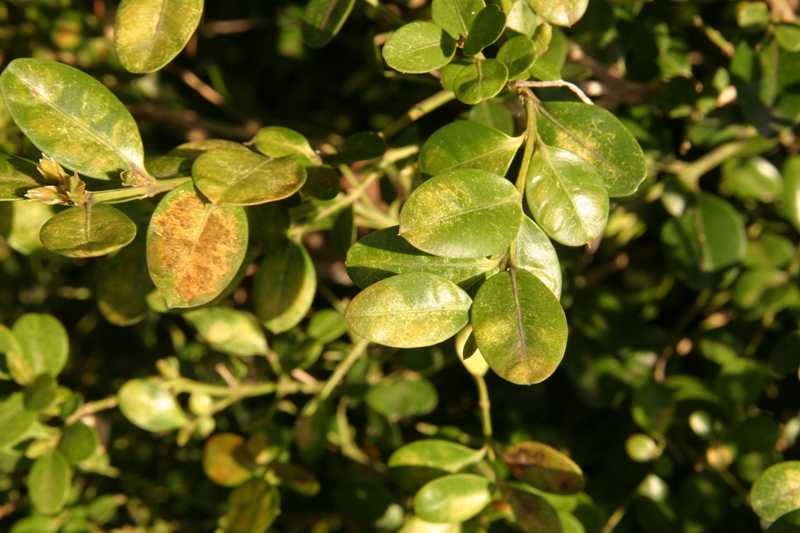This is the third part of a series on summer tree insects. This article examines boxwood leafminer, and cooley spruce gall adelgid.
Introduction
As spring transitions into summer, temperatures gradually rise, and plants enter the next phase of their development. This period coincides with the appearance of numerous insects, many of which infest vulnerable trees and shrubs. When infestations occur, they can be detrimental to plant health. The following discusses some of the insects that commonly infest plants in summer, and how they impact their hosts.
Boxwood Leafminer (Monarthropalpus flavus)
Boxwood leafminer is a small midge that feeds on the leaves of boxwood. It is considered the most serious pest of boxwood. During its larval stage, boxwood leafminer feeds on the upper and lower portions of the plant’s leaves, causing significant blistering and discoloration. As temperatures cool, the larvae cease feeding, and overwinter in the blisters. The adults resemble yellow to orange-red mosquitoes.
Hosts
Boxwood leafminer consumes the leaves of American boxwood, littleleaf boxwood, and common boxwood. It may also be found on English and Japanese boxwood, albeit with less frequency. The slower growing English varieties exhibit greater resistance to the insect than the American varieties.
Symptoms of Infestation
The larvae feed between the upper and lower parts of boxwood leaves. This causes blisters to form on the underside of the leaves. Blistering may not become apparent until late summer. Leaves infested by boxwood leafminer are often stunted, appearing smaller, and dropping prematurely. Yellow or brown splotches form on infested leaves. When boxwoods are severely infested, the leaves will become laden with blisters. Heavy infestation can result in significant defoliation, and tree mortality.
Treatment
- When planting, consider selecting resistant cultivars. Cultivars of English boxwood, such as Buxus sempervirens ‘Pendula’, ‘Suffruticosa’, ‘Handworthiensis’, ‘Pyramidalis’, ‘Argenteo-varigata’, and ‘Varder Valley’ exhibit an increased resistance to the insect.
- Maintain plant vigor through sound cultural practices. Ensure plants are sufficiently watered, especially during extended periods of drought. Apply a layer of organic mulch around susceptible plants to improve soil quality, moderate soil temperature, and retain soil moisture.
- Encourage the development of natural predators such as green lacewings, and spiders. This will limit the density of boxwood leafminer populations.
- Prune boxwoods before adults emerge, or just after the adults lay their eggs in May. This will help reduce leafminer populations.
- Rake and dispose of fallen leaves to reduce the potential for leafminer outbreaks.
- Insecticide applications can be administered to control leafminer populations. Begin treatment in mid-April to early May, when the adult flies can be observed hovering around boxwoods. Perform a second application in mid summer.
- Foliar systemic insecticides are effective when leafminers are present in the leaf blisters.
- Soil applications of dinotefuran or imidacloprid are effective at controlling leafminers. Dinotefuran is diffused more rapidly into the soil, allowing for faster control.
Cooley Spruce Gall Adelgid (Adelges cooleyi)
Cooley spruce gall adelgid is a small black insect that is native to North America. During the nymphal stage of the insect’s life cycle, the nymphs crawl into the expanding buds of host plants, and proceed to feed on the elongating needles. The persistent feeding of the nymphs promotes abnormal plant cell development in the buds. This causes the formation of galls on several spruce trees, as well as needle distortion and discoloration on Douglas-fir. Severe infestations can deform trees, and inhibit their growth.
Hosts
The most common host plants for cooley spruce gall adelgid are Colorado blue spruce, and Douglas-fir. The pest also infests Engelmann spruce, Sitka spruce, and Oriental spruce.
Symptoms of Infestations
On spruce twigs, the feeding of the nymphs induces the formation of galls on the branch tips. When infestations are severe, the resulting bud deformation can distort the tree. Galls range from ½ an inch to three inches in diameter. The gall formed on spruces is an elongate growth shaped like a pineapple. Galls are initially green, but turn brown by late summer. Galls may persist for several years. Galls are not formed on Douglas-fir, but feeding by the species on the needles may cause needle discoloration, and needle distortion, with infested needles becoming bent or crooked. Infested needles often drop prematurely. As the insects feed on the needles, they secrete a substance called honeydew. Sooty mold often develops on the honeydew. This causes the infested branches to assume a blackened appearance. On Douglas-fir, the waxy masses may be observed on infested needles in early spring. Once the eggs hatch, the nymphs will also feed on developing cones. Significant damage to the cones can inhibit seed production.
Treatment
- On small spruce trees, remove and dispose of the green colored galls during June or July, prior to the adults’ emergence. This will help to limit adelgid populations.
- To manage the overwintering females, registered insecticides can be applied on spruce and Douglas-fir from mid-September to early October.
- Applications of dormant oil may be administered to control the overwintering nymphs. Applications should be performed before new growth emerges in early spring, or in early fall after the first frost has occurred.
- Encourage the development of natural predators, such as lacewings, assassin bugs, and lady beetles.
Photo courtesy of Missouri Botanical Garden


